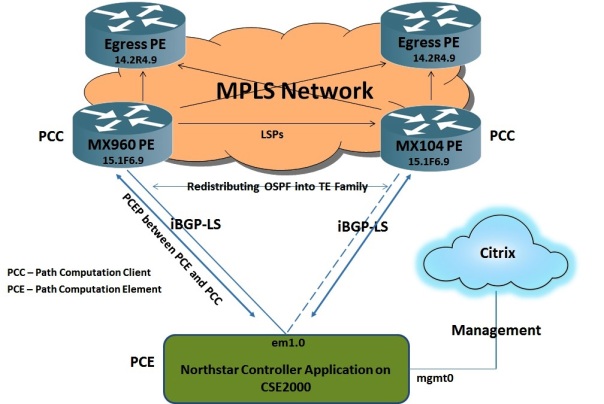Biggest misconception I think currently with SDN is that in order to run SDN we need to have OpenvSwitch equivalent switch supporting Openflow protocol between Controller and Switch. Most software vendors are promoting their software under this category however Hardware vendors who have spent considerable money on building hardware platforms are not just selling switches supporting Openflow. They are using SDN to come up with other applications which are centrally controlling the network and influencing the network from single point but not using Openflow protocol.
Juniper has one of the similar product under WAN–SDN controller category named Northstar. I just happen to assess it recently for my Telco.
Northstar comes in two flavours, Controller and Planner. Controller enables granular visibility and control of IP/MPLS tunnels in large service provider and enterprise networks.
Northstar Planner is more of modelling tool which can help you in understanding the behaviour of new LSP addition, deletion, failure of node/link etc. on your network before you actually provision the network.
The NorthStar Controller relies on PCEP (Path Computation Element Protocol) to deploy a path between the PCC routers. The path setup itself is performed through RSVP-TE signaling, which is enabled in the network and allows labels to be assigned from an ingress router to the egress router. Signaling is triggered by ingress routers in the core of the network. The PCE client runs on the routers by using a version of the Junos that supports PCEP.
The NorthStar Controller provisions PCEP in all PE devices (PCCs) and uses PCEP to retrieve the current status of the existing tunnels (LSPs) that run in the network. By providing a view of the whole network state and bandwidth demand in your network, the NorthStar Controller is able to compute optimal paths and provide the attributes that the PCC uses to signal the LSP.
Example Topology

If your network supports Point to Multipoint LSPs, then you need minimum of 15.1F6 version on your ingress PE to view P2MP LSPs on Northstar controller however Egress PE can be on any version. Northstar initiates an iBGP-Link state session between itself and Ingress PE and PCEP attributes are shared over this session.
Home Page:

With Northstar, we can view all the LSPs in network from the point of view of Ingress PE supporting PCEP and from there on we can initiate an LSP and delegate LSP from PE to Controller to manage it.
Northstar lets you create single LSP, multiple LSPs at once and even diverse LSP by site or link which could be very useful in case of primary backup paths in order to protect against single source of failure.
Diverse LSP Provisioning

There are three types of TE LSPs used with PCEP
- CLI-controlled LSPs—The LSPs that do not have the lsp-external-controller pccd statement configured are called CLI-controlled LSPs. Although these LSPs are under local router control, the PCC updates the connected PCE with information about the CLI-controlled LSPs during the initial LSP synchronization process.
- PCE-controlled LSPs—The LSPs that have the lsp-external-controller pccd statement configured are called PCE-controlled LSPs or delegated LSPs. The PCC delegates the PCC-initiated LSPs to the main PCE for external path computation.
- Externally-provisioned LSPs (or PCE-initiated LSPs)—The LSPs that have the lsp-provisioning statement configured are called PCE-initiated LSPs. A PCE-initiated LSP is dynamically created by an external PCE; as a result, there is no LSP configuration present on the PCC.
In its current version, Northstar is really impressive and only thing lacking at the moment in its in-ability to create P2MP LSPs which is must for broadcast applications in NG-MVPN environment and Juniper has plans to include this in their coming releases by end of 2017.
I am sure Service providers will surely think of using Northstar in their IP/MPLS Network where they are using Traffic Engineering LSPs in order to give them more flexibility and control over there traffic bandwidth demands.
Let me know your views on it and would you be interested to deploy this onto your network 🙂
R
Mohit Mittal
Great Article!!!
LikeLike
Thanks John 🙂
LikeLiked by 1 person
Hi Mohit
I’m POC testing Northstar currently and there quite a few limitations though I don’t doubt its power.
-P2MP-TE support as you pointed out
-Inter-AS TE support though this is limited also in Junos itself (OSPF only and no P2MP Inter-AS TE) some hacks are available around manual methods for this point but not addressed in NS
-I doubt multi vendor support , I managed to get XR code 6.x working with stable BGP-LS and PCEP 5.x trains the BGP-LS session keeps bouncing, and it definitely does not provision a PCEP automated tunnel using RSVP TE from my testing
Some other good things to point out in that I have been able to provision SPRING PCEP initiated LSP (again no P2MP or Inter-AS support mainly down to implementation of SPRING today)
For diverse LSP’s you need to consider where their is explicit LSPs then you need a backup the-tunnel ideally not doing fate sharing etc.
But if you have dynamic LSPs via RSVP or SPRING then there are LFA/RLFA options in Junos that divert the dynamic LSPs without traffic loss (tested and did not lose 1 packet) this includes link and node protection mechanisms.
LikeLike